Thrift算是一种常见的RPC框架,我工作中也常常接触到。
基于0.5.0版本
简介
Thrift作为一种接口定义语言(IDL)和二进制通信协议被应用在程序设计的服务创建和定义中,我们更常见称呼Thrift为RPC框架。 在使用Thrift中,我认为Thrift有如下特点:
- 支持语言众多。拥有自成一体的IDL,各种语言C++、Java、Python等都有实现。
- 传输性能优秀。RPC性能对比不错,很多大公司,还有组件(Hadoop、Hive等)都使用它。
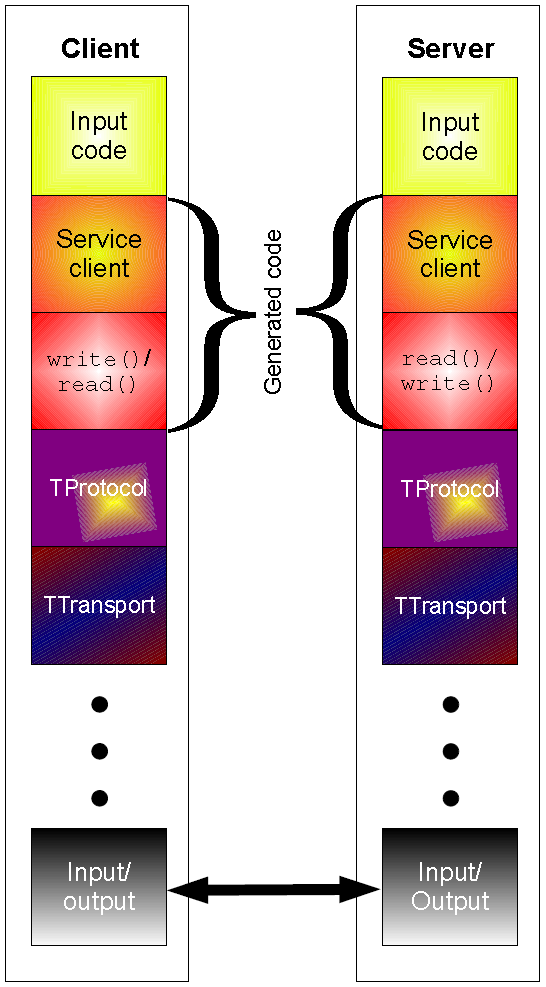
组件职责和传输
Thrift官网有介绍Thrift Server的网络层和各组件作用,我们跟着顺藤摸瓜:
+-------------------------------------------+
| Server |
| (single-threaded, event-driven etc) |
+-------------------------------------------+
| Processor |
| (compiler generated) |
+-------------------------------------------+
| Protocol |
| (JSON, compact etc) |
+-------------------------------------------+
| Transport |
| (raw TCP, HTTP etc) |
+-------------------------------------------+
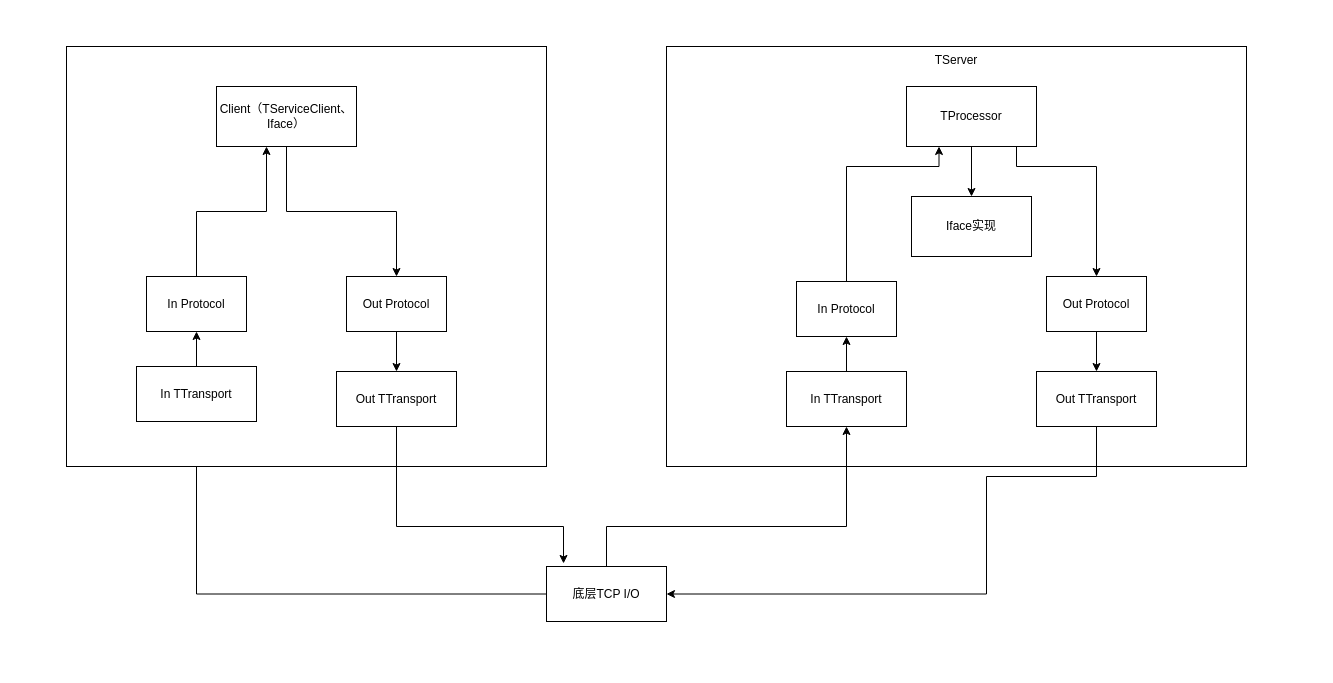 上图给出整体流程图,我这里一一说下:
上图给出整体流程图,我这里一一说下:
- Transport 网络传输封装,TCP、HTTP之类。最终传输层协议实现有在类中生成socket,也有会抽象一层TSocket去做。
- TFramedTransport
- TNonblockingTransport
- THttpClient
- Protocol 传输序列化协议
- TBinaryProtocol
- TCompactProtocol
- TJSONProtocol
- TProcessor thrift代码生成,传输及序列化流程处理
- TServer 处理网络流程执行,数据处理整个流程
- TSimpleServer
- TThreadPoolServer
- TNonblockingCompleteServer
- Client和TServiceClient thrift生成的代码,client端调用使用
协议分析
Strict Binary协议
调用示例
enum TypeEnum {
UNKNOWN = 0;
ADMIN = 1;
NORMAL = 2;
}
struct Req {
1:i32 id;
2:TypeEnum type;
3:string name;
4:map<string, string> parameters;
5:bool fill_info;
}
struct UserInfo {
1:i32 id;
2:TypeEnum type;
3:string name;
4:map<string, string> parameters;
5:bool status;
}
service SimpleThriftService {
string knock(1:string msg);
UserInfo getUserInfo(1:Req req);
}
TTransport transport = new TSocket("localhost", 9090);
TProtocol protocol = new TBinaryProtocol(transport);
SimpleThriftService.Client client = new SimpleThriftService.Client(protocol);
transport.open();
Req req = new Req(1, TypeEnum.NORMAL, "test", new HashMap<String, String>() {{put("k", "v");}}, false);
UserInfo userInfo = client.getUserInfo(req);
分析字节码
以使用最广的strict Binary协议为例,基于上面示例调用,进行了抓包,结合文档对字节码进行直观分析。
注:wireshark抓包的话自带了一些方便的标注。
这里只标注了client请求协议体,server reply返回的消息格式相同。
//Message
80 01// 10000000 00000001 首位1标识为strict binary protocol, 其余15位标识版本号
00 // 无用字节
01 // message type消息类型 1:CALL
00 00 00 0b // 方法名长度 11
67 65 74 55 73 65 72 49 6e 66 6f // 方法名:getUserInfo
00 00 00 01 // seq id顺序id,client用这个号去处理消息的失序响应
//Struct
0c // field类型:T_STRUCT
00 00// field id: 0
00 // 类型: T_STOP
0c // field类型:T_STRUCT
00 01 // field id: 1
08 // field类型:I32
00 01 // field id: 1
00 00 00 01 // int32值=1
08 // field类型:I32
00 02 // field id: 2
00 00 00 02 // int32值=2
0b // field类型:BINARY
00 03 // field id: 3
00 00 00 04 // BINARY field会带length,为4
74 65 73 74 //string值为test
0d // field类型:MAP
00 04 //field id: 4
0b //key type: BINARY
0b //value type: BINARY
00 00 00 01 //map的item数,该例子为1
00 00 00 01 //length:1
6b //值为 k
00 00 00 01 //value length:1
76 // 值为 v
02 // field类型:BOOL
00 05 //field id: 5
00 //值为FALSE
00 //T_STOP 标识STRUCT结束
00 //T_STOP 标识整体数据结束
协议格式
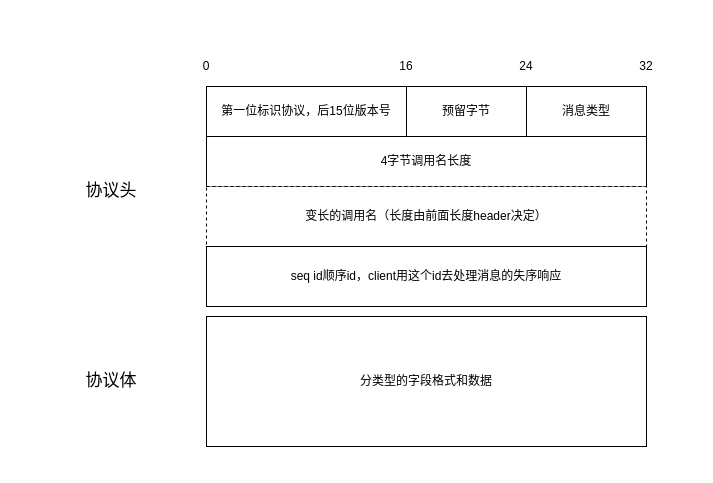
1. 协议头
分为这四种消息类型
- Call: 1 client发送的消息类型,指代需要响应的消息。
- Reply: 2 server回复响应的消息。
- Exception: 3 server异常消息。
- Oneway: 4 client发送的单向消息,不需要返回。
2. 协议体

- 一般定长数据:i32、i64、BOOL等,采用TV模式,字段类型(1字节)+ field id(2字节)+ 值
- 变长数据:STRUCT、BINARY、MAP、LIST、SET等,采用TLV模式,字段类型(1字节)+ field id(2字节)+ field length (4字节) + 值
定长数据类型
| 数据类型 | 字段类型(1个字节) | 类型尺寸(单位:字节) |
|---|---|---|
| bool | 2 | 1 |
| byte | 3 | 1 |
| double | 4 | 8 |
| i16 | 6 | 2 |
| i32 | 8 | 4 |
| i64 | 10 | 8 |
变长数据类型
| 数据类型 | 字段类型(1个字节) | 类型尺寸(长度 + 值) |
|---|---|---|
| string | 11 | 4 + N |
| struct | 12 | 嵌套数据 + 1个字节停止符STOP(00) |
| map | 13 | 1 + 1 + 4 + n*(k+v) |
| set | 14 | 1 + 4 + N 【val类型 + item数 + 值】 |
| list | 15 | 1 + 4 + N 【val类型 + item数 + 值】 |
老(non-strict)Binary协议
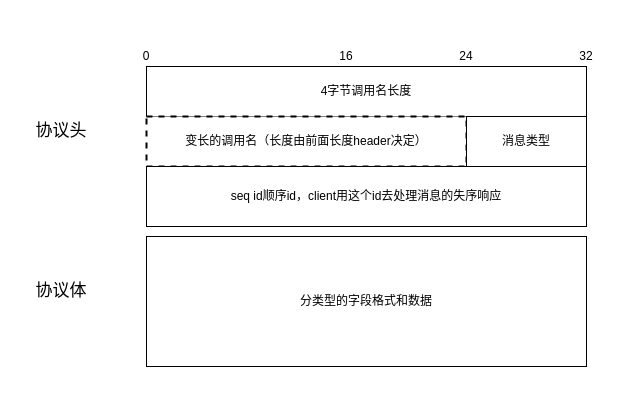 字段分析同上。
字段分析同上。
Compact协议
协议格式
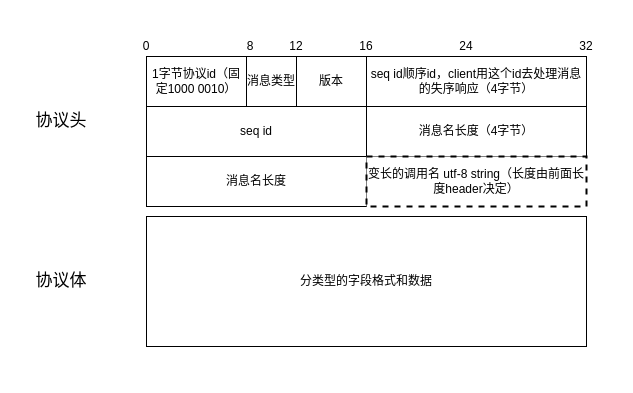
1. 协议头
对比Binary协议,将消息类型和版本做了压缩,头字段排列做了优化。
2. 协议体
协议体的压缩主要是通过zigzag和var int(protobuf也用到这两算法去做压缩),对数字类型和变长字段的length头做压缩。
Zigzag
作用:能够将有符号数压缩为无符号整数。从而减少存储和传输空间。
int32算法:(n << 1) ^ (n >> 31)
举例:处理整数 1和-1。
原始:00000000 00000000 00000000 00000001
左移位n << 1:00000000 00000000 00000000 00000010
右移位n >> 31:00000000 00000000 00000000 00000000
异或:00000000 00000000 00000000 00000010
原始:11111111 11111111 11111111 11111111
左移位n << 1: 11111111 11111111 11111111 11111110
右移位n >> 31:11111111 11111111 11111111 11111111
异或:00000000 00000000 00000000 00000001
经过编码后,-1转换为无符号整数,方便压缩。
Var int
作用:能够将正整数压缩字节数,结合zigzag能够减少存储和传输空间。
例子:转换数字123456 -> 结果10111001 01100000
//算法:复制自TCompactProtocol
public static byte[] toVarint32(int n) {
byte[] i32buf = new byte[5];
int idx = 0;
while (true) {
if ((n & ~0x7F) == 0) {
i32buf[idx++] = (byte)n;
// writeByteDirect((byte)n);
break;
// return;
} else {
i32buf[idx++] = (byte)((n & 0x7F) | 0x80);
// writeByteDirect((byte)((n & 0x7F) | 0x80));
n >>>= 7;
}
}
return i32buf;
}
数字123456:00000000 00000000 00110000 00111001
1次循环:10111001
2次循环:10111001 01100000
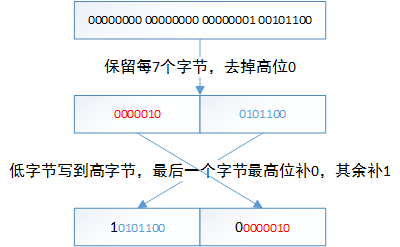
需要注意:compact协议的对小数值数字,压缩能力好,但是对于大数,压缩能力有限。
JSON协议
json协议编码在Thrift不常用且不建议用,这里不打算说。
Reference
[1]https://en.wikipedia.org/wiki/Apache_Thrift
[2]https://thrift.apache.org/docs/concepts.html
[3]https://developer.aliyun.com/article/643859
[4]Thrift spec https://github.com/apache/thrift/blob/master/doc/specs/thrift-rpc.md
[5]https://github.com/apache/thrift/blob/master/doc/specs/thrift-binary-protocol.md
[6]https://zhuanlan.zhihu.com/p/476213759
[7]https://www.linux88.com/zigzag/